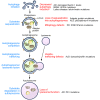Autophagy and neurodegeneration
- PMID: 25654552
- PMCID: PMC4382230
- DOI: 10.1172/JCI73944
Autophagy and neurodegeneration
Abstract
Most neurodegenerative diseases that afflict humans are associated with the intracytoplasmic deposition of aggregate-prone proteins in neurons. Autophagy is a powerful process for removing such proteins. In this Review, we consider how certain neurodegenerative diseases may be associated with impaired autophagy and how this may affect pathology. We also discuss how autophagy induction may be a plausible therapeutic strategy for some conditions and review studies in various models that support this hypothesis. Finally, we briefly describe some of the signaling pathways that may be amenable to therapeutic targeting for these goals.
Figures


References
Publication types
MeSH terms
Substances
Grants and funding
LinkOut - more resources
Full Text Sources
Other Literature Sources
Medical
Molecular Biology Databases
Miscellaneous

